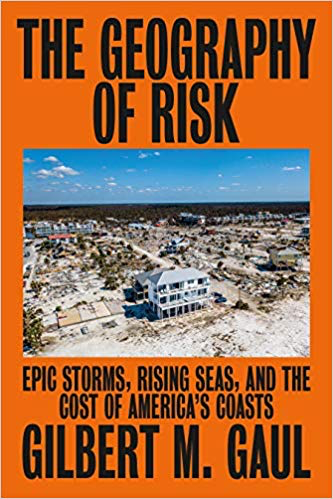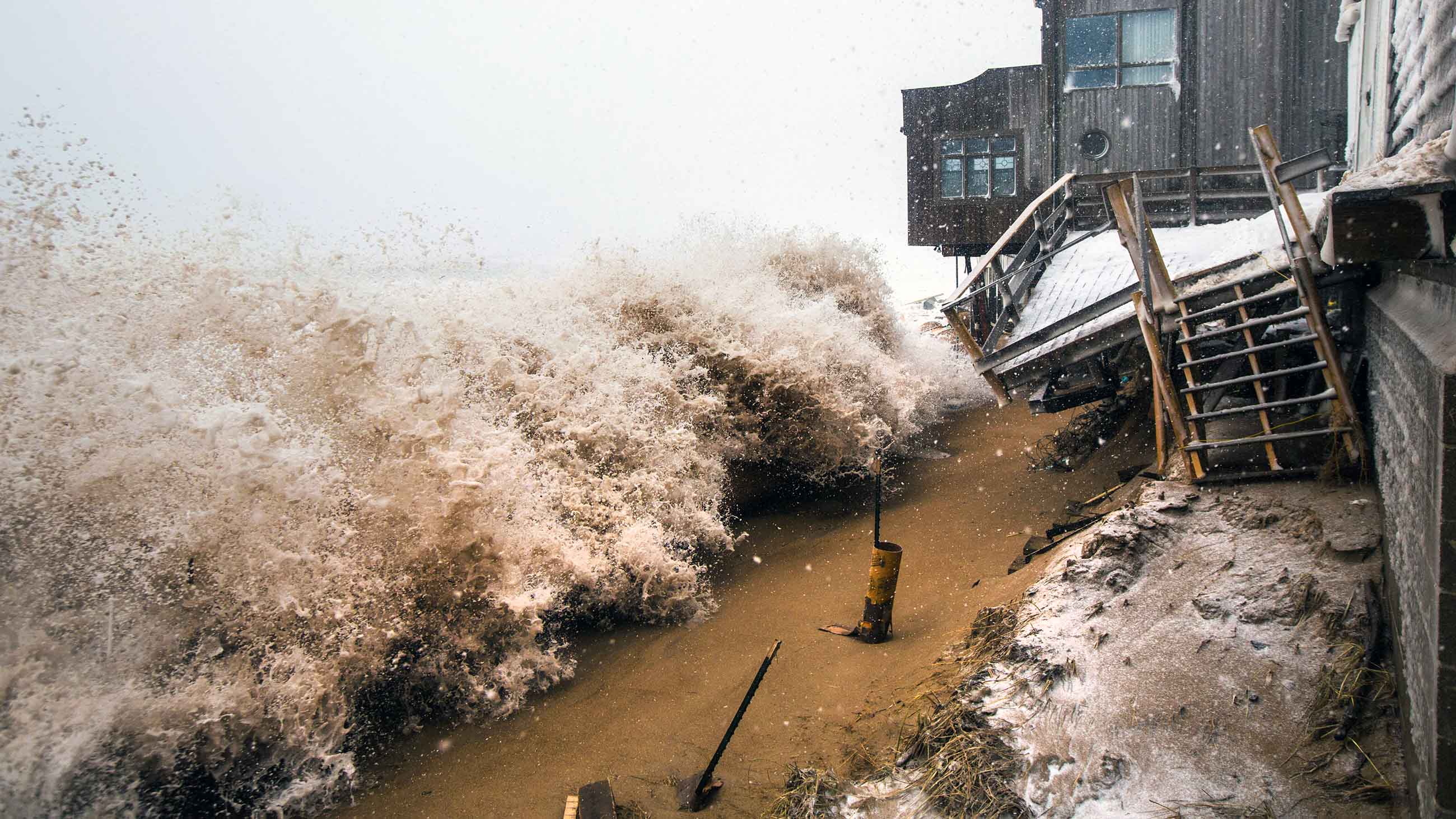In the mid-1980s, a contingent of Wall Streeters began snatching up property along the East Coast to build second homes. On Long Beach Island in New Jersey, one of them complained to the mayor of the town that he was unhappy about the weather. “He wanted me to do something,” the mayor recalled, in Gilbert M. Gaul’s new book, “The Geography of Risk: Epic Storms, Rising Seas, and the Cost of America’s Coasts.” “I looked at him and said, ‘What do you want me to do? You want me to stop the rain?’”

In “The Geography of Risk,” Gaul focuses on the characters involved in development and planning.
This is the kind of story Gaul uses to illustrate the “reckless development of the coasts” and sense of entitlement of some of those involved in developing and purchasing homes in high-risk coastal zones. Gaul, a former investigative journalist for The Washington Post and other newspapers, and a two-time Pulitzer Prize winner, argues that the storms are not only extremely costly — totaling $750 billion of damage over the last two decades — but appear to be getting more severe.
In “The Geography of Risk,” Gaul focuses on the characters involved in development and planning: the politicians who make decisions about protecting coastal zones and offer subsidies for damage; the insurers who make hundreds of millions of dollars in profits; and the scientists who study the environmental factors, enhanced by climate change, that have caused some of the biggest storms in history.
Gaul says it’s hard to argue that any specific hurricane is directly caused by climate change. Still, he says rising temperatures are helping create conditions for more severe storms, and we ought to “figure out how much it is contributing, and how that is likely to change as we go forward if the planet continues to warm.”
For this installment of the Undark Five, I spoke with Gaul about why coastal storms are becoming more severe and the link between hurricanes and climate change, among other topics. Here is our conversation, edited for length and clarity.
Undark: You write about a period of time, specifically between 1945 and 1971, when there was a great deal of development in New Jersey: 30,000 acres of coastal wetlands were dredged and filled. How does it illustrate the environmental toll of development on the shores?
Gilbert M. Gaul: The coastal damage during that period affected about one third of the coastal wetlands in the state of New Jersey. This happened up and down the Atlantic and Gulf Coast during this period of what I refer to as the “modern coast,” which was happening in the postwar boom when people with money were building second homes on barrier islands or coastal floodplains — places where they shouldn’t be going.
If you’re going in with a dredge and tearing up the wetlands, you are destroying the valuable spawning grounds for all manner of critters, from terrapins to blue claw crabs to fish. You are destroying valuable migratory pathways for birds.
What I was largely interested in was: How did this change the coast, and make it more vulnerable to storms?
In Hurricane Sandy in 2012, the majority of the damage in New Jersey was on the back sides of the barrier islands. And in Barnegat Bay and Ocean County, New Jersey, which was ground zero for the hurricane, there was extraordinary damage. Roughly 70 to 75 percent of all the damage from the storm in New Jersey was on these back bays — we hadn’t seen it before. During the building of the modern coast, we had put in over a hundred thousand houses along the bays by digging up old wetlands and marshes and filling them in — those zones where we’re now vulnerable.
The wetlands essentially act as a sponge. They help to absorb storm surge and wave action during hurricanes and nor’easters and act as a buffer for the property behind it.
UD: What are the incentives for rebuilding in high-risk areas?
GG: The National Flood Insurance Program (NFIP) insures millions of homes in coastal flood plains prone to, now, fairly routine flooding, and occasional epic storms such as Sandy, Florence, Katrina, and Ike. These coastal properties account for three-quarters of the program’s losses, and a preponderance of the program’s $24 billion in debt. Somewhat shockingly, about 1.5 million of these properties are beach houses and investment properties. Why is the federal government in the business of insuring beach houses? Especially, given the growing risks in an age of climate change.
Coastal property owners have never paid premiums reflecting the actual risk of flooding. The NFIP improbably awarded huge discounts to older, riskier properties that flooded repeatedly. And, until recently, it operated without any reserves. When big storms such as Harvey in 2017 resulted in massive claims, it borrowed from the U.S. Treasury — another form of a subsidy.
There is an array of other subsidies that encourage unchecked or even reckless building in floodplains They range from federal grants for roads and bridges, to disaster relief for beach towns and municipal governments, to pumping sand in front of million-dollar beach houses to widen the eroding beaches
UD: When we look at the history of hurricanes, there seems to be a more recent breed of superstorms that are more powerful than what we’ve had before. What’s happening there?
GG: The research indicates that they’re getting more severe. We certainly can look at the last few years and point to the uptick in the number of Category 5 storms, the number of major hurricanes that hit Florida in the last three years.
Kerry Emanuel at MIT has shown that with climate change, there’s the warming planet and then transfer of the energy or heat from the warming planet into the oceans, because the oceans are the primary storage for those rises in temperatures. The oceans become warmer, which is just fuel for hurricanes. Hurricanes in the future could be 45 percent more powerful than hurricanes today.
The storms seem to be amplifying rather quickly. You will see a tropical storm turn into a Category 3 or a Category 4 or even a Category 5 hurricane in a matter of, two days. That’s unusual.
The other thing that’s been happening lately — and this could be just a coincidence — is that these large hurricanes like Harvey and then Florence are stalling out as they reach the coast.
UD: Can you talk about the technology behind hurricane prediction? And if we know that hurricanes are inevitable, why don’t we prepare for them before the meteorologists tell us there’s a storm coming?
GG: Our ability to predict hurricanes has increased exponentially over time. If you look at the models, there are dozens of so-called “spaghetti strings” — which is what the lines on the maps look like when they converge — and the European models are just extraordinary on short-term predictions. One of the models on Sandy actually predicted eight days out that the hurricane would take this unusual hard left-hand turn into the state of New Jersey. That’s exactly where that happened.
But it’s really hard to say exactly where the worst winds and storm surges are going to come in within, say, 50 miles or 100 miles.
So, we’ve built $3 trillion worth of property. That’s my conservative estimate. Some people use $10 trillion. Much of that is second homes. There’s not an inch of coast that isn’t developed in New Jersey. We rebuild after storms in the exact same places and congratulate ourselves for doing it, as if it’s our patriotic duty. And act surprised when the next big storm comes in and wrecks the place.
UD: How is the science behind coastal damage influencing decision making? When does it actually make a difference?
GG: In the age of Trump, it’s not going to make a difference, because the Trump folks are dismissive of scientists and climate change. They’re doing everything possible to undo what we’ve done in the recent past to help us deal with some of the impacts of climate change. So the effects are going to be worse going forward.
That said, folks in the universities and research centers continue to do great work. The folks who study risk management at places like Wharton and the American Institute of Research are doing great work.
It’s not like we’re not getting the message. So it becomes — are there communities and towns that are trying to do smart things?
There are some things at the margins that are being done that are kind of helpful and kind of interesting as part of what they call “coastal sustainability” or ‘‘coastal resiliency.” Which are terms that unfortunately, in my view, are fuzzy.
On Staten Island, they bought out pretty much a neighborhood that got wrecked after Sandy, and that was a good move. But here in New Jersey, we had $300 million to buy out damaged places after Sandy, or to offer people a chance to move. Supposedly, we couldn’t find anyone along the coast willing to take a buyout. It’s really hard to do buyouts. After Harvey, there were something like 75,000 properties that were eligible for a buyout. Last time I looked, they had agreements with 2,000 to buy out.
The focus in Texas seems to be on armoring the coast. Building a huge surge gate. Not necessarily a bad thing, but it’s horrifically expensive, and it wouldn’t do a darn thing to help the people in Houston if another Harvey came in. Harvey was a rain bomb, not a storm surge, and Houston’s far enough from the coast that the storm surge wouldn’t be the real problem.
In the end, there’s so much property in the wrong places that we’re going to continue to see horrific damages.
Hope Reese is a writer and editor in Louisville, Kentucky. Her writing has appeared in Undark, The Atlantic, The Boston Globe, The Chicago Tribune, Playboy, Vox, and other publications.










